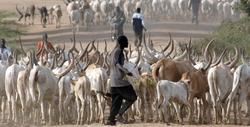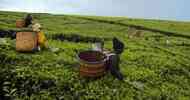IPS | 13 June 2011
By Simba Russeau
CAIRO - The escalation of violence around the north-south border in the run-up to Sudan’s big divide has sparked fears of a new civil war, but experts contend that the issue is more about land and water rather than oil.
"Population claim to the land is more important to the main tribal groups than oil," professor of political science at the American University in Cairo, Ibrahim El Nur, told IPS.
"Abyei is like Kashmir in terms of population composition - which is made up of residents with historical ties to both the south and north – competing interest over key water sources like the Kiir or the Bahr el Arab, claims to pastureland, and ambiguous borders."
Situated within a large rift basin known as the Muglad Basin, Abyei is the 10, 460 square kilometre disputed region straddling the North-South border.
A 2005 Comprehensive Peace Agreement (CPA) put an end to Africa’s longest-running civil war, granted Abyei special status and also called for a Joint Integrated Unit (JIU) comprised of soldiers from the north and south.
Nine months before the CPA, the Abyei Protocol was signed allowing residents to vote in a referendum on Jan. 9 but a voting rights dispute between the Misseriya tribe and the Ng’ok Dinka as to who was eligible to decide the future of Abyei postponed the referendum indefinitely.
The Greater Nile Oil Pipeline running through the Abyei area carrying more than one quarter of Sudan’s oil exports from the Heglig and Unity oil fields to the Red Sea’s Port Sudan was also seen as a major sticking point between the two sides until The Hague 2009 Permanent Court of Arbitration ruling, which granted the north rights to maintain the oil.
"When oil was discovered in the Muglad basin, which straddles southern Kordofan and western Upper Nile, the government in Khartoum also opposed the holding of an Abyei referendum and imprisoned anyone who campaigned for it," said Douglas Johnson, author of The Root Causes of Sudan’s Civil Wars, in an interview with IPS.
"The Misseriya feared that if the Ng’ok voted to join the south restrictions by southern police – which already exist in Bahr el Ghazal and Upper Nile - would apply to the Ng’ok grazing areas as well. At the same time the expansion of mechanised farming areas throughout southern Kordofan took pastoral land out of use, and the growth of both Misseriya and Ng’ok cattle herds placed these remaining grazing lands under increased pressure."
The Nile River, flowing some 6,700 kilometres through ten countries in northeastern Africa making it the longest river in the world, is a vital source of water for Egypt and Sudan.
Distribution of the Nile Basin Initiative, which is a cooperative agreement for developing the river among the ten countries, relies on colonial contracts signed in the 1930s. However, a 1959 re- negotiated agreement between Sudan and Egypt allocating 23 billion cubic metres of the Nile’s annual flow to Sudan and 55.5 billion cubic metres to Egypt could be disrupted with the secession of the south.
"For Egypt, the flow of the Nile waters is a matter of life and death. If any country were to affect the Nile’s flow upstream then it would be a case of war for Egypt. This is why the Mubarak regime preferred to have turmoil in Sudan than to have a strong government that could make proper use of the Nile, adds El Nur.
"Another source of tension is the development of land grabbing phenomenon where investors from Arabia and China invest in Sudan’s agriculture, which makes the negotiations difficult because it’s not Sudan developing its agricultural sector, it’s others coming to hire land and water to produce agricultural crops to send back to their countries," Dr. Hammou Laamrani, Water management expert with the International Development Research Centre in Cairo told IPS.
"During Sudan’s transition phase everything is likely to be a source of conflict on the border - not only water but oil, land, movement of populations and cattle."
In Sudan, which is the largest country in Africa, the climate ranges from arid in the north and northwest to wet-and-dry tropical weather in the southwest. In western regions where the climate is semi-arid, safe drinking water is in short supply.
Rainfall, which is a key resource in Sudan, diminishes from south to north with the annual average varying from 120cm in the south to less than 10cm in the north.
Given Sudan’s rainfall patterns, the Misseriya – who are seasonal nomads from the north – rely on access to the waterways and grazing areas of the sedentary Ng’ok – who have historical ties to the south – to maintain their herding and farming lifestyle during the dry season.
"The Misseriya and the Dinka have developed different breeds of cattle: the Misseriya needing cattle who can survive on the hotter, sandier soils north of the qoz belt that separates them from the Ng’ok, and the Ng’ok needing cattle better suited to the wetter, swampier conditions of the Kiir waterways," adds Johnson.
"The end of the first civil war and the creation of the Southern Region coincided with a severe downturn in rainfall levels in central Sudan, so the southern waterways and grazing lands became even more important to the Misseriya than before 1969."
"If you look at the situation of Darfur those conditions are not excluded because the conflict has also come to an issue of land and water," adds Laamrani.
"Agriculture is the main generator of employment and income in these areas so it would make sense that a greater share of water and land, which is a driver of economic development, would be cautioned by the north."
The Sudan crisis has prompted the African Union (AU) to hold a two-day mini summit in Addis Ababa to discuss key issues ahead of the south’s independence, which include the withdrawal of troops, deployment of an African-led security patrol and a settlement on Abyei’s regional status.














